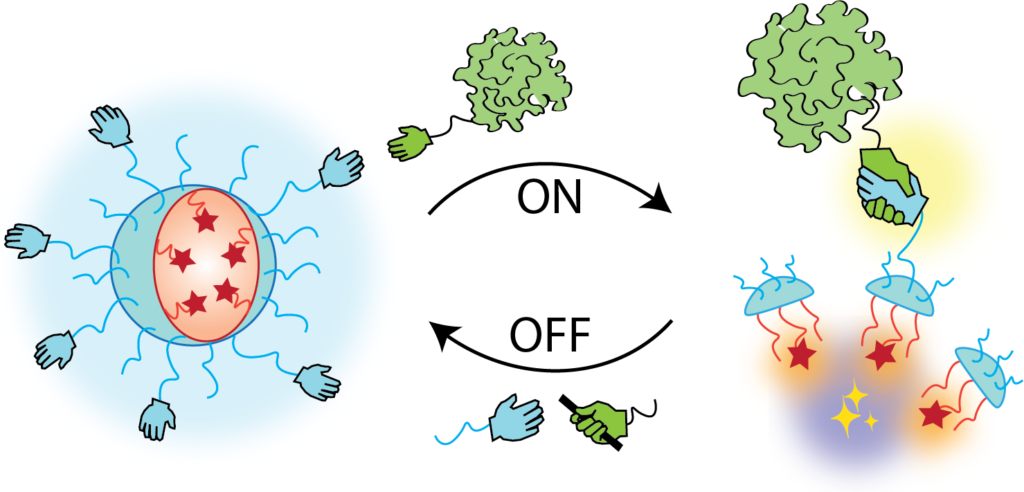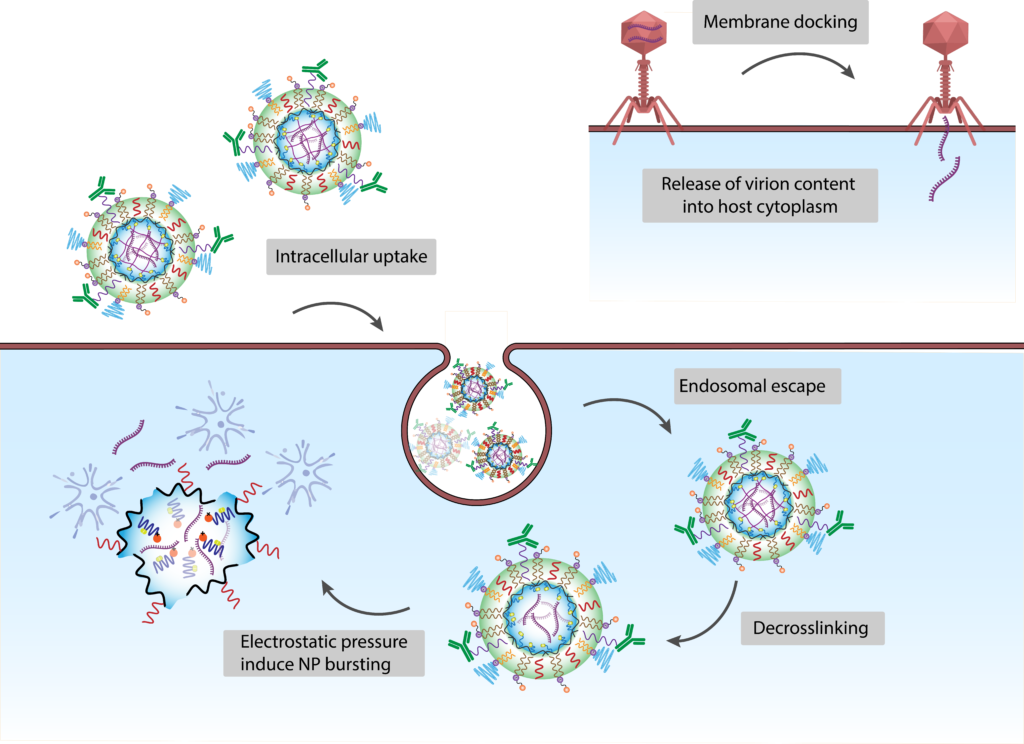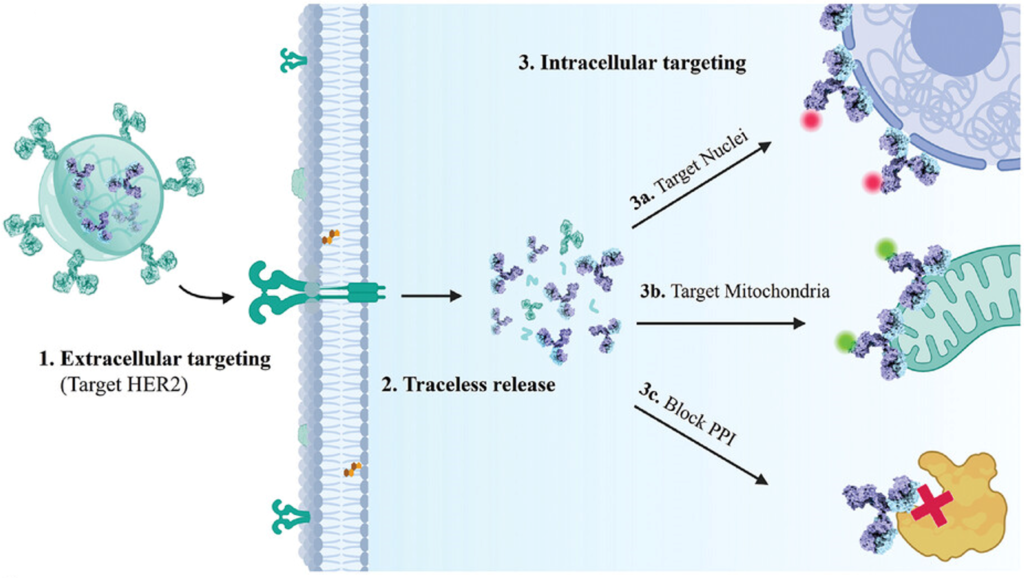Tunable Supramolecular Constructs
Supramolecular assemblies, especially those that can be achieved in aqueous media, have been attractive as these should be capable of non-covalently encapsulating guest molecules in one environment and releasing them in another. If this change in environment is relevant to the differences encountered in health vs. disease tissues, then the implications are even higher. Considering these, there have been great advances in designing stimuli-sensitive supramolecular assemblies. However, these have mainly focused on secondary imbalances in biology (e.g. pH, temperature, redox conditions, etc.). Since primary imbalances in biology involve a change in protein activity, generating supramolecular assemblies that respond to proteins is exciting. Our goal is to obtain a better understanding of the structural factors that control the assembly/disassembly events in response to the concentration of a specific protein or the activity of an enzyme. The structural requirements for achieving control over these assembly /disassembly events are quite stringent. Using our custom-designed small molecule amphiphiles, facially amphiphilic dendrimers and amphiphilic homopolymers, we take a concerted approach to achieve controlled disassembly of well-defined amphiphilic assemblies in response to a specific protein stimulus, providing insight into the structural underpinnings of supramolecular disassembly.
 Angew. Chem. Int. Ed., 2021, 60, 27189–27194
Angew. Chem. Int. Ed., 2021, 60, 27189–27194
Targeted Protein Degradation
Governing the concentrations and localizations of nearly 30000 proteins is a complex cellular process that involves both synthesis and degradation. Eukaryotic cells use proteasomes (UPS) for short-lived proteins and lysosomes for long-lived proteins, aggregates, and organelles, for protein degradation ensuring a dynamic equilibrium. However, diseased cells overexpress specific proteins that have a profound impact on their viability, for example, transcription factors that impact cancer cell proliferation. A compelling strategy is to degrade a protein in its entirety using molecular degraders that target disease relevant proteins, consequently, making the molecular design of these targeted protein degraders indispensable. Our research leverages invigorating triggerable functionalities, polymers, and antibodies to target diseased cells and facilitate degradation of rogue proteins.

BioRxiv, 2024, (https://doi.org/10.1101/2024.09.18.613672)
Targeted delivery of biologics: Protein and RNA
There has been a boom in using biologics as therapeutics with m-RNA vaccines demonstrating promise. Conventional non-viral delivery systems use dense cationic charge for biologics encapsulation, leading to cytotoxicity, while viruses face limitations during in-vivo use. Our solution is to create non-cationic, non-toxic triggerable nanogels using self-assembling functional polymers for biologics delivery, releasing cargo in the cytoplasm in response to a specific intracellular cue. Our nanogels are modified with surface functional groups that dictate cellular targeting through incorporating ligands and antibodies that target specific overexpressed receptors on cells, while achieving endosomal escape through coated functionalized lipids.

ACS Appl. Mater. Interfaces, 2019, 11, 28, 24971–24983
Responsive Nanomaterials
Nanomaterials that predictably respond to an external stimulus or a combination of stimuli are of great interest, because of their implications in a rather broad range of applications. The primary design challenge concerns two factors: input (stimulus or stimuli) and output (response). For example, one could design materials that are responsive to pH changes, yielding a response in the form of a molecular release. The ability to tailor the molecular design to achieve materials that respond to a broad range of inputs, yielding a broad range of outputs has significant implications in a variety of areas. When focusing on an application, although our primary design will provide the fundamental structure-property relationship handles, secondary design challenges emerge. In drug delivery, for example, the molecular design needs to account for factors such as encapsulation stability, drug loading capacity, and biocompatibility. Within drug delivery, there are tertiary design challenges, dictated by the specific disease targeted. In our group, we are focused on developing generalized principles that underlie responsive molecular assemblies and the resultant materials. By addressing the primary design challenge, we have developed and are developing capabilities to tackle a broad range of challenges including drug delivery, diagnostics, and sensing. Prominent examples of materials developed in our group for this purpose include a novel self-crosslinking polymeric nanogel for drug delivery and kinetically-trapped amphiphilic homopolymers for sensing in complex milieu.

Small, 2024, 20, 2402874
Completed Projects
Molecule and Materials for Harnessing Solar Energy
Organic photovoltaics undergo four fundamental processes to convert sunlight to electrical energy: exciton generation (light absorption), exciton dissociation resulting in free charges (charge separation), charge migration (charge transport), and charge collection. The area of organic photovoltaics has been a challenging prospect for the chemical community, because well-defined molecular design algorithms do not exist to concurrently optimize all the four processes mentioned above. In our group, we take a systematic approach to make in-roads into this problem. For example, systematic structure-property relationship studies with polymers are inherently complicated, because of the heterogeneity of the samples that one obtains during syntheses. On the other hand, designing molecules that preserve supramolecular organization for charge separation and charge transport, while also exhibiting broad light absorption is also a challenge. We are beginning to address these issues by starting with building blocks that are inherently low energy absorbers (e.g. BODIPY). Our earlier contributions in this have revolved around optimizing the early events (light absorption and charge separation) in macromolecules such as dendrimers and polymers. Our current work combines our earlier findings (as well as others’) to develop a unified set of molecular design guidelines for organic photovoltaics.
